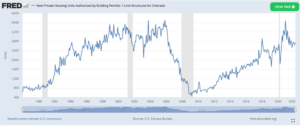If it’s springtime in the Rockies, then it’s time for the Democrat-controlled Colorado legislature to sneak in last-minute bills to make your life more complicated, more expensive, or both.
This year’s edition, House Bill 22-1362 involves forcing local governments to adopt expensive “green” housing codes, significantly raising the cost of new houses, especially new single-family housing. This will be fine for the laptop class who can afford the extra costs right now, but it will drive the dream of home-ownership over the horizon for many more.
The bill comes at a time when housing costs – including rent – are already consuming more of Coloradans’ incomes. Using 2019 pre-pandemic data, US News ranked Colorado 48th in housing affordability, behind only Hawaii and the progressives’ model state of California. ATTOM’s Home Affordability Report for the first quarter of 2022 showed every one of the 11 counties surveyed with an affordability index of 84 or less (100 is the historical average), and 10 of the 11 at 80 or lower. Almost all of those counties required 35% or more of median income to buy. A widely-cited report from just a couple of weeks ago showed Denver to be the fifth-least affordable housing market in the entire country, breaking the bottom five for the first time.
Make no mistake – this is a supply-and-demand imbalance that has been made worse by regulations discouraging new building. Active listings and days-on-market are highly seasonal, so we need to either use annual averages or comparisons to similar parts of the cycle. Right now, total listings in Colorado are down 66%, two-thirds, from the same time in 2019, and even down 11% year-over-year, at a time when we’re supposed to be recovering from the Covid restrictions. Houses are staying on the market about two-thirds as long as they were as recently as late 2019, and the median price listing per square foot is up 64% since 2016.
Part of the reason that there are so few houses for sale is that so few houses have been built. Current housing starts only recently peaked at 2006 levels, even as they collapsed in the wake of the financial crisis, and as the state’s population continued to boom. They have since declined again (see graph 1).
With relatively fewer new homes on the market, people have no place to go if they want to remain in Colorado, which is certainly contributing to the growing number of people leaving.

Bill sponsors would like to claim that increasing the cost of new housing will actually make housing more affordable, because of the long-term energy savings. In July 2021, the federal Department of Energy estimated that the incremental cost of moving from the 2018 International Energy Conservation Code (IECC) standard to the 2021 IECC standard, which is the basis for HB-1362, would be $4800 for the average new home in Colorado, the incremental increase in the payback period would be 3 years, and the total savings over 30 years would be $7,100 in today’s dollars.
The National Association of Home Builders (NAHB) begs to differ, calculating the total cost to be $11,000 only from the move to the 2021 code. When additional restrictions are added in, that number skyrockets to over $57,000.
Even on its own terms the government estimate is almost certainly far too optimistic. It assumes a mortgage rate of 3%, but national mortgage rates are nearly twice that already. The cost of materials assumptions use pre-pandemic numbers, adjusted by the overall Consumer Price Index (CPI) as of 2021. This completely fails to capture even the vast increase of lumbers costs, currently roughly three times what they were in 2019 (see graph 2), affecting not only the down payment, but also the mortgage payments.
Moreover, by only looking at the marginal effect of adding the 2021 standard to the 2018 standard, DOE is able to ignore the cumulative effect these changes are having affordability. By their own calculations, the simple payback period – the unfinanced, up-front cost – of adding the 2021 to the 2009 standard is nearly 11 years statewide.
Ironically, one underestimate – inflation and especially energy inflation – makes the payback period look better, but only for those few who can alread y afford the new house to begin with. For everyone else, all it does is squeeze budgets even more, making it that much harder to save for that ballooning down payment.

The response of the sponsoring Democrats has been either to deny or to ignore these inconvenient truths. The gaslighting would be impressive if the price of natural gas weren’t also through the roof.
They would like you to believe that raising the price of housing increases home affordability.
They would also like you to forget the uproar after the Marshall Fire, when the cities affected were forced by a furious citizenry to suspend implementing exactly these rules, or risk leaving much of their populations permanently displaced.
They would like you to forget their hostility to the suburbs, and their boosterism for an increasingly two-tier economy that mimics California’s.
Most of all, they would like you to forget that this bill will have real consequences for real families, today. For the first time decades, more people are leaving the state than moving in, and the main reason for that reversal is housing costs.
I’m going to give the last word to former state representative Rob Witwer, posted on Twitter: “The [affordability] problem falls disproportionately on the shoulders of people with lower incomes and young people. Home ownership is what allows people to build a family, become vested in their community, and build a foundation to someday give back to that community. It’s a good thing, something public policy should encourage.”
Joshua Sharf is a senior fellow in fiscal policy at the Independence Institute, a free market think tank in Denver.


